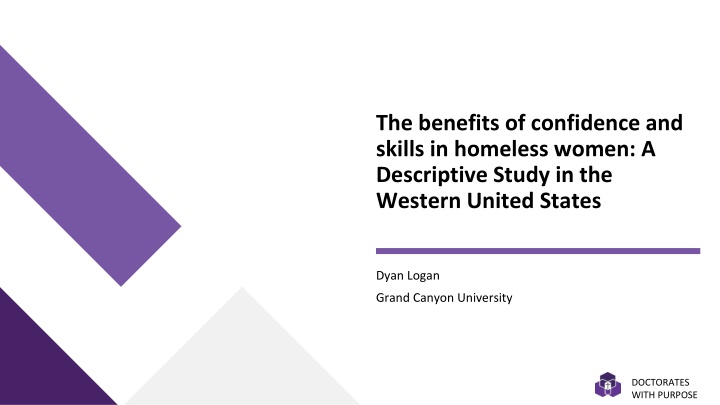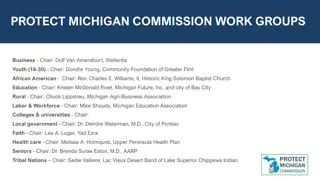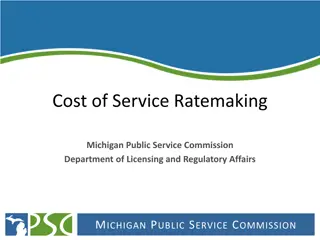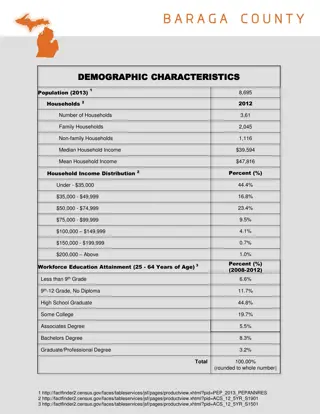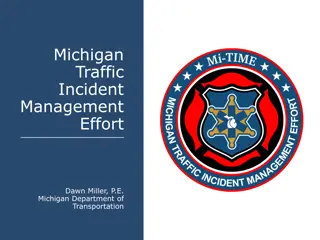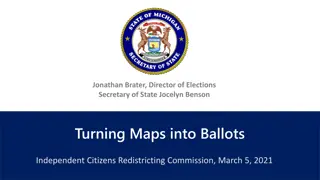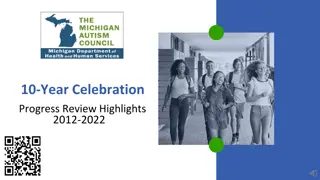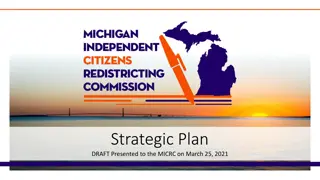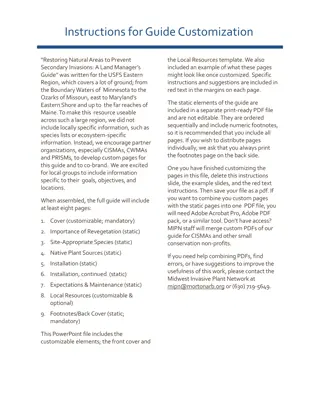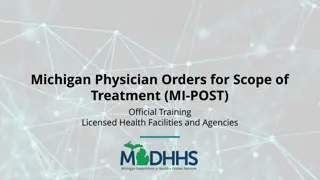Michigan School Scorecards - Draft 2014-15 Data Analysis
Explore how to access and analyze draft 2014-15 Michigan school scorecards securely. Learn to download AYP student data files, filter columns in MS Excel, and categorize data for assessment participation and proficiency. Obtain guidance on filtering criteria, including enrollment verification and district/building code matching. Enhance your understanding of school accountability data processing with step-by-step instructions provided in the content.
Download Presentation

Please find below an Image/Link to download the presentation.
The content on the website is provided AS IS for your information and personal use only. It may not be sold, licensed, or shared on other websites without obtaining consent from the author.If you encounter any issues during the download, it is possible that the publisher has removed the file from their server.
You are allowed to download the files provided on this website for personal or commercial use, subject to the condition that they are used lawfully. All files are the property of their respective owners.
The content on the website is provided AS IS for your information and personal use only. It may not be sold, licensed, or shared on other websites without obtaining consent from the author.
E N D
Presentation Transcript
The benefits of confidence and skills in homeless women: A Descriptive Study in the Western United States Dyan Logan Grand Canyon University DOCTORATES WITH PURPOSE
Dyan, Thank you for your submission. This is my first review of your prospectus. Your study addresses an important and timely topic, and you have thought deeply about the subject.I have commented and asked questions in the sidebar to help you think about the issues that must be addressed to improve your study. The comments are designed to help you strengthen your work. Consider this a conversation. Please read all the comments before attempting to make any edits. Note that when you click on one of the sidebar balloons, the section it is connected to on the page will be highlighted. If you have questions or want to meet as a committee, please get in touch with your chair to set that up. This prospectus will serve as a guide (outline) for setting up your proposal, so paying close attention to the details is important. Of primary import are: 1. Establishing the problem space 2. Alignment problem space-problem statement-purpose statement design-research questions. 3. Design justification 4. Data analysis You have the basics, but I am struggling to understand who your population is and how you will access this population. The problem statement is not directly supported by the problem space that you have developed. Consider a broader look at what it means to be a homeless mother caring for a child. I recommend that you switch to the new template and process with this edit. You can access Version 10 Dissertation Templates and the Companion Guides under the Dissertation Resources tab on the home page. Here are the direct links to these fantastic new resources: Dissertation Templates Qualitative Companion Guide Quantitative Companion Guide Please see the comments throughout. You have put great effort into this, and I look forward to working with you as your work develops. Dr. Comi
Alignment Table Purpose Statement: Problem Statement: The purpose of the proposed qualitative descriptive study is how homeless mothers incorporate confidence and skills to overcome economic hardship. It is not known how homeless mothers incorporate confidence and skills to overcome economic hardships. Phenomena The central research phenomenon of interest is the confidence of homeless mothers living in poverty. Research Question(s): RQ1: How do homeless mothers in the western United States incorporate their confidence and skills to overcome economic hardship? RQ2: How do homeless mothers in the western United States incorporate their skills to succeed to economic hardship? Methodology & Justification: Design & Justification: A qualitative methodology is ideal for this study as it explores the experiences of homeless women, focusing on their confidence and skills. This approach allows for in-depth understanding through personal experiences. It provides flexibility to adapt to diverse individual stories, highlighting empowerment and resilience, while exploring how these women navigate control over their circumstances in the Western United States of America. Descriptive Approach The descriptive approach aligns with the research goals, by enabling a comprehensive view of the lived experiences of homless mothers, and captures the diversity of experiences across different communities in the western United States. The expected outcome of this research will benefit by contributing to the field of social work, public health, and/or policy-making regarding homelessness. (Siedlecki, S. 2020) DOCTORATES WITH PURPOSE
Literature Review: Background to the Problem DOCTORATES WITH PURPOSE
Literature Review: Problem Space What is known: Credential: Slesnick et al. (2023) conducted a quantitative experiment on 160 young homeless people and found that housing support services and improved self-efficacy helped overcome problems such as substance use. Credential: Warburton et al. (2022) studied homeless women, including 163 single mothers and 126 lone women. They found that reasons for homelessness and the challenges faced by homeless women were diverse and heterogeneous. What is unknown: Credential: Thulien et. al. (2023) conducted a mixed methods study scaffolded by community based participatory action axiology in practice; the research was longitudinal qualitative study of 24 participants over a period of two years. They studied the overall experience of homeless youth who exist on the border of socioeconomic inclusion and exclusion. They found that the experience of participants in this liminal space was complex and nonlinear. As a limitation, they noted that the study was limited to primarily urban Canadian youth and suggested that the experience of the liminal space between socioeconomic inclusion and exclusion for other populations may differ. Credential: Clark et al. (2024) studied an intervention meant to improve self-efficacy for self-care for homeless people. Their study included 62 male participants and the results of the intervention showed significant benefits from improved self-efficacy. They noted that existing research has typically not studied the self-care, agency, or self-efficacy of those experiencing homelessness. Credential: Graf et al. (2022) conducted a qualitative study using structured interviews, that included 40 African American women experiencing homelessness. They studied what helped at-risk mothers succeed on their own. They and found themes of mental health included Impacts of adverse childhood experiences, lack of social networks, child placement in foster care, and implications on self-esteem and self-worth (p. 167).They highlighted a limitation was looking at only graduates from one program and additional information may have been gathered if looked beyond successful graduates. Synthesis: The importance of self-efficacy for homeless people has been established, as have the diverse challenges facing homeless mothers. However, research is still needed to understand the full experience of homeless mothers, and the role of self-efficacy in that experience. Therefore, the problem is that it is not known how homeless mothers describe the skills necessary to overcome economic hardship. DOCTORATES WITH PURPOSE
PROBLEM STATEMENT It is not known how homeless mothers incorporate confidence and skills to overcome economic hardship DOCTORATES WITH PURPOSE
Literature Review: Theoretical Foundations Social cognitive theory by Bandura. The theoretical foundation for the proposed study is Bandura's social cognitive theory. SCT originated by Albert Bandura in 1986 and is central to self efficacy. SCT is a theory of learning and the central construct of this study is confidence that is closely related to skills. confidence reflects a person's own self-assessment of their ability to complete a task (Bandura, 2001). As evidenced in prior studied, Slesnick et al., (2023) explains that confidence is an important attribute for overcoming homelessness. Those who possess confidence have greater skills and are more likely to actively pursue steps to elevate themselves out of homelessness and/or poverty. thus the ability to overcome is important to fight with homelessness. (2023). DOCTORATES WITH PURPOSE
Literature Review: Review of Literature Major Topic/Theme Major Topic/Theme (name the topic) (name the topic) Topic/Theme Description Topic/Theme Description (2 (2- -3 sentences with at least 3 in 3 sentences with at least 3 in- -text citations per topic) text citations per topic) [Garcia 2024, Graf et al. 2022) identified substance use, ethnicity, and immigration status are interrelated. Intersectionality Intersectionality [Galvin et al. 2024, Ervin et al. 2022, and Chan et al. 2021] identified pregnancies, motherhood, single mother are facing violence from partners. Interventions: Family Connections Family Connections [Mallory et al. 2022, and Semborski et al. 2021] multiple interventions are at play for multiple purposes. Intervention Intervention [Rew et al, 2022 and O'Shaughnessy et al. 2022] illustrated the importance of confidence and how this will help get away with the challenges with great ease. Self Self- -Efficacy Efficacy DOCTORATES WITH PURPOSE
Problem Statement It is not known how homeless mothers incorporate confidence and skills to overcome economic hardships. DOCTORATES WITH PURPOSE
Phenomenon The central research phenomenon of interest is the skills need to overcome economic hardship of homeless mothers living in poverty. DOCTORATES WITH PURPOSE
Research Questions RQ1: How do homeless mothers incorporate their confidence to overcome economic hardship? RQ2: How do homeless mothers incorporate their skills to overcome to economic hardship? DOCTORATES WITH PURPOSE
Methodology Justification Qualitative Qualitative Quantitative Quantitative Main attributes of qualitative methodology: The study of people and their experiences, activities, and relations by using a large volume of descriptive information is called qualitative research. It aims at capturing phenomenon in their day-to-day settings, focusing on how participants make sense of events (Galvin et al., 2024; Graf et al., 2022, p. 124). The change is based on structured and exploratory data collection techniques like interviews and a thematic analysis approach that helps to get at the much significant systematic patterns and themes on complicated social concerns like homelessness and confidence (Bimpson et al., 2022). Main attributes of quantitative methodology: Quantitative research uses numbers and statistical techniques in order to determine the extent of the association between variables. It is formal, quantitative, and concerned with extending a finding from one population to another employing such an instrument as survey or experiment (Bandura, 2001; Kohler et al., 2024). It is useful for research insofar that it helps in determining trends and relationships between variables but is generally not sufficient enough where the researcher is interested in meaning making or understanding the social context of an individual s behavior. Justification for qualitative: The qualitative research plan for this study is to conduct a Evidence Based interventionto capture valuable information proviiding beneficial help to strengthen their confidence and abilities which will enhance the resilience of homeless mothers,. Justification against quantitative: Actually, quantitative paradigms are off track for this study because they prefer variables to illustrate Confidence and abilities in Homeless Mothers rather than genuine testimonials. This research necessitates the investigation of affective, relational, and DOCTORATES WITH PURPOSE
Justification (use /not use) Design Definition Design Qualitative Descriptive Definition: Qualitative Descriptive focuses on providing a detailed description of a phenomenon, without necessarily aiming for theory development. Justification to use this research design. Qualitative Descriptive is selected for the proposed topic as it aligns with the research goal of providing a comprehensive description of the incorporation of confidence and skills in homeless women without the need for extensive theory development. Phenomenological Phenomenology aims to explore and understand lived experiences, perceptions, and meanings associated with a particular phenomenon. Phenomenology explores lived experiences, focusing on subjective meanings. For "The benefits of confidence and skills in homeless women," a descriptive design better examines patterns, trends, and observable outcomes. Narrative A qualitative descriptive design focuses on providing a comprehensive summary of participants' experiences and the context of a specific phenomenon, using straightforward descriptions Narrative design focuses on individual life stories, emphasizing personal experiences. For "The benefits of confidence and skills in homeless women," it s not ideal as the study aims to analyze broader trends and patterns. Case Study Case study design involves an in-depth, detailed examination of a specific individual, group, organization, or event to explore complex phenomena within a real-world context, using multiple data sources. Case study design focuses on an in-depth analysis of a single case or small group. For this research, a broader descriptive approach better captures trends among homeless women in the Western United States. Grounded Theory Grounded theory on the other hand is a systematic approach designed for the development of the theory from the data collected from the participants with the use of the constant comparative analysis The study does not aim at developing a brand new theory of its own, but rather aims to qualify and explain experiences in light of one or several theories (e.g. Social Cognitive Theory). DOCTORATES WITH PURPOSE
Feasibility Slide 1 Resources for Study Participant Access: Using local homeless shelters and other organizations operating in the Western part of the United States, the researcher will find participants among homeless women with children. Ethical Concerns Informed Consent: All participants will be told about the study and they will sign a consent form. Privacy and Confidentiality: All data will be stripped of any identifiers and will secure methods usually followed by the IRB for a period of five years. Data Collection Tools: Quantitative data will be obtained through guided, but open-ended, interviews using semi- structured interview guides and portable voice recorders. Voluntary Participation: Subjects are free to leave at will during all stages of the experiment. Research Support: Access to the library of the SEC as well as other institutions where the theoretical frameworks can be accessed and a temporal use of analytical tools such as NVivo for data analysis as well as ethical direction. Fortunately, this research is possible due to the abundant resources along with participation of homeless shelters for sample collection. Semi-structured interviews will prove to be fruitful for acquiring qualitative data that will be analyzed using software: NVivo. Concerns to ethical sensitiveness like privacy and consent are addressed here by having stringent measures like anonymization and IRB compliance. It meets institutional objectives and takes advantage of resources, e.g., the SEC library for investigation and theory. This way, the study minimises logistical and ethical issues that can compromise the study s validity but prioritise the confident and capabilities of homeless mothers living through economic challenges. Sensitive Nature: Participants will be provided with the necessary social and psychological support when explaining certain ideas or experiences. DOCTORATES WITH PURPOSE
Feasibility Slide 2 Feasibility Concerns Study Alignment with Program (Identify Program of Study) One challenge is aligning time frames with the schedules of participants in the benefits of self- efficacy and agency in homeless women study to ensure data collection is completed before the end of the program. To address this, I will engage in regular check-ins with key contacts and stakeholders to synchronize schedules and manage any potential conflicts. Degree & Emphasis: Doctor of Philosophy in General Psychology Alignment of topic to degree: This study will align with my Doctor of Philosophy in General Psychology by enhancing my understanding of qualitative research methodologies and interviewing techniques. It will provide practical experience in analyzing qualitative data from interviews, which is crucial for advanced psychological research. Additionally, this study will deepen my knowledge of training approaches and their impact, contributing to a more comprehensive understanding of applied psychology within diverse training contexts. Another obstacle is securing access to necessary resources, such as equipment or data sources, during critical phases of the research. To overcome this, I will prioritize booking resources as early as possible and coordinate with relevant organizations and technical staff to ensure their availability when needed. DOCTORATES WITH PURPOSE
Purpose Statement The purpose of the proposed qualitative descriptive study is to explore how homeless mothers incorporate confidence and skills to help them overcome economic hardship in the western United States. DOCTORATES WITH PURPOSE
Population, Target Population, & Sample General Populationco Target Population Sample Women from low-income areas, living below poverty line 100 10 to 15 Women living in low- income areas who have experienced poverty within the last five years and exploring the benefits of confidence and skills to overcome economic challenges. 100 Women living in low- income areas in western USA who have experienced poverty within the last five years and exploring the benefits of confidence and skills to overcome economic challenges. A sample size of 20 women to be recruited but 10 to 15 will be used for the interviews. DOCTORATES WITH PURPOSE
Data Collection Steps: Slide 2 Sampling Strategy and Sample Selection Primary Sampling (Plan A) Backup Sampling (Plan B) Churches, social media and outreach programs. Steps to Access/Identify Participants for homeless mothers in the western U.S. Criteria Convenience sampling will be used to recruit participants from local shelters, community centers and food banks that specifically serve homeless families or those who have experience homelessness within the last five years. Criteria: Understanding the challenges and needs of homeless mothers pregnant or with children to inform policy and support services.(McGeough, C., et al. (2020). Switching from in-person to online surveys to collect demographic data and quantify specific needsand/or flyers This approach is beneficial as it allows for quick access to target population Collaborate with shelters /community organizations. Create information flyers for engaging techniques. Focus beino on one major drawback - the potential for bias, as the sample may not represent the broader population accurately. This can lead to skewed results that affect the study s reliability DOCTORATES WITH PURPOSE Sampling Strategy & Convenience sampling Snowball sampling.
Instrumentation & Data Sources Data Source #1 [Identify Source Here] Semi-Structured Interviews Total: 10-15 interviews Duration: 1 Hour (60 minutes). Researcher created with expert panel and field testing DOCTORATES WITH PURPOSE
Data Collection Steps: Required Permissions Required permissions/approvals (prior to data collection) Site approval (if applicable) GCU Chair and Committee Approvals AQR Approval IRB Approval Informed Consent form from individual participants DOCTORATES WITH PURPOSE
Data Collection Steps: Collecting the Data The subject matter expert panel will review results for qualitative instruments. Like, semi-structured interviews to validate as effective tools and procedures. Field testing will be conducted. Send/post Flyers Consent Forms (prior to data collection) individual participants ensure voluntary participation and understanding of the study's purpose and procedures. DOCTORATES WITH PURPOSE
Data Collection Steps: Data Management and Storage Where will you store the data? Data will be securely stored on password-protected electronic devices, such as encrypted computers or external hard drives, to prevent unauthorized access. How long will you store the data? Data will be retained for a minimum of five years following the completion of the study, as per institutional guidelines, to ensure availability for potential audit or verification purposes How will you protect the data? Data will be protected through encryption, access controls, and regular backups to mitigate the risk of loss or unauthorized disclosure. Only authorized researchers will have access to the data. How will you destroy the data? At the end of the retention period, data will be securely deleted using data destruction software or physically destroyed through shredding to ensure irretrievability. Confirmation of data destruction will be documented for record-keeping purposes. DOCTORATES WITH PURPOSE
Data Analysis Steps: Analysis Strategy (Braun & Clark, 2006) Step 1: Read and re-read the data to immerse yourself, noting initial ideas. Step 2: Identify and highlight relevant features of the data systematically. Step 3: Group similar codes together to identify potential themes. Step 4: Refine themes, ensuring they accurately reflect the data. Step 5: Define themes clearly and name them to capture their essence. Step 6: Write a compelling narrative linking themes to the research question. DOCTORATES WITH PURPOSE
References Bandura, A. (2001). Social cognitive theory: An agentic perspective. Annual review of Psychology, 32(1), 1-26. Bhatia, M. (2023). Reproductive injustice in Britain: punishing illegalized migrant women from the Global South and separating families. Identities, 30(4), 471-489. Bimpson, E., Parr, S., & Reeve, K. (2022). Governing homeless mothers: the unmaking of home and family. Housing Studies, 37(2), 273-291. Braun, V., & Clarke, V. (2006). Using thematic analysis in psychology. Qualitative Research in Psychology, 3(2), 77 101. https://doi.org/10.1191/1478088706qp063oa Chan, C., Sharvet, (2021). Associations of intimate partner violence and financial adversity with familial homelessness in pregnant and postpartum women: A 7-year prospective study of the ALSPAC cohort Research Article https://journals.plos.org/plosone/article?id=10.1371/journal.pone.0245507
References Chan, C., Sharvet, (2021). Associations of intimate partner violence and financial adversity with familial homelessness in pregnant and postpartum women: A 7-year prospective study of the ALSPAC cohort Research Article https://journals.plos.org/plosone/article?id=10.1371/journal.pone.0245507 Clark, SM. Roger, Reeb, RN , et. al. (2024). Benefits of a health advocacy intervention intended toimprove self-efficacy for self-care in residents of a homelesss shelter Department of Psychology (University of Dayton) https://doi.org https://doi.org/10.1080/10852352.2023.2299895 Erwin, J. Taouk, Y,Al;fonzo, LF., et al. (2022). Longitudinal association between informal unpaid caregiving and mental health amongst working age adults in high-income OECD countries: A systematic review eClinical Medicine https://www.thelancet.com/journals/eclinm/article/PIIS2589-5370(22)00441-2 Galvin, A. M., Akpan, L. N., Lewis, M. A., Walters, S. T., & Thompson, E. L. (2024). Reproductive interconception care among women recently pregnant and homeless: a qualitative analysis. Health Education & Behavior, 37(2), 302-310.
References Garcia S. Duran, K., Kushel, M. (2024 Homelessness And Health: Factors, Evidence, Innovations That Work, And Policy Recommendations Health Affairs. https://www.healthaffairs.org/doi/full/10.1377/hlthaff.2023.01049 Graf, M. D. C., Dressel, A., Schmitt, M., Deal, E., Pittman, B., Lopez, A., Mkandawire, A. Valhmu, L. (2022). "I was broken in so many different ways": The intersection of complex factors impacting homeless and at-risk African American women's mental health and well-being. International Journal of Mental Health Nursing, 31(1), 167-178. Kohler, A., Pylypchuk, N., & Retsdorfer, E. (2024). Adverse childhood experiences, mothers and homelessness: a narrative review and recommendations. Cogent Social Sciences, 10(1), 2391533. Lucke, C. M., Narayan, A. J., Monn, A. R., & Masten, A. S. (2022). Social support and parenting among mothers experiencing homelessness. Parenting, 22(4), 277-285. https://doi.org/10.1080/15295192.2021.1882830
References Mallory, AB, Luthy, E. Martin, JK., et al. (2022). Variability in treatment outcomes from a housing intervention for young mothers misusing substances and experiencing homelessness. Children and Youth Services Review https://www.sciencedirect.com/science/article/abs/pii/S0190740922001906 McGeough, C., et al. (2020) Barriers and facilitators perceived by homeless women https://doi arg./10.1111/12972. Cot 31. O Shaughnessy, T., et al. (2022) The Career Adjustment Experiences of Women Early Career Psychologist. The Counseling Psychologist.https://journals.sagepub.com/doi/abs/10.1177/0011000016650264 Rew, N Slesnick, S Kesler, H Rhee - Nursing research, 2022. Mediation of Psychological Capital in Youth Experiencing Homelessness. Mediation of Psychological Capital in Youth Experiencing Homelessness Nursing Research. https://journals.lww.com/nursingresearchonline/abstract/2024/05000
References Semborski, S. Redline, B. Madden, D, et al. (2021) Housing interventions for emerging adults experiencing homelessness: A scoping review Children and Youth Services https://www.sciencedirect.com/science/article/abs/pii/S0190740921001602. Siedlecki, S. (2020) Understanding Descriptive Research (Design and Method Understanding Descriptive Research Designs and Methods). https://www.researchgate.net/publication/338300876 Slesnick, N. Zhang, J., Feng, X., et al. (2023) Housing and supportive services for substance use and self- efficacy among young mothers experiencing homelessness: A randomized controlled trial, Journal of Substance Abuse Treatment. https://www.sciencedirect.com/science/article/abs/pii/S0740547222001994 Thulien, N. (2023). When I think about my future, I just see darkness Qalitative research.nCanadian Journal of Public Health (2023) 114:893 905 ttps://doi.org/10.17269/s41997-023-00804-2 Warburton, W., Whittaker, E., & Papic, M. M. (2018). Homelessness pathways for Australian single mothers and their children: an exploratory study. Societies, 8(1), 1-22. Article 16. https://doi.org/10.3390/soc8010016
